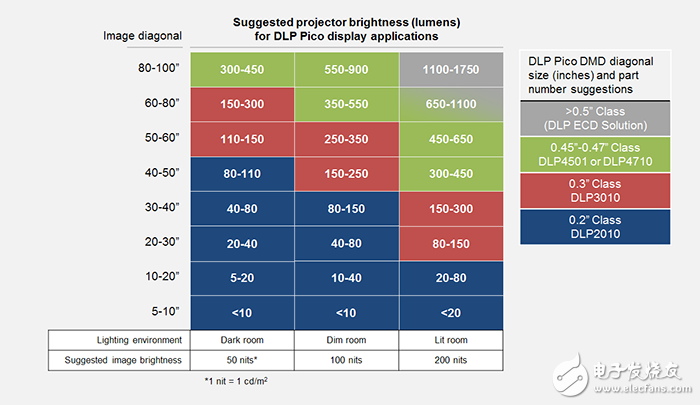Three factors analysis of optimizing the brightness of miniature projection system
Usually when customers first contact TI DLP® Pico ™ display technology, the two most common problems are:
♦ How much brightness do I need (measured lumen)?
♦ In my complete system, how much brightness can be achieved in the end?
Brightness [1] seems to be a simple technical indicator. But for a particular miniature projection system, how much brightness is needed and how to balance various aspects of system design when achieving higher brightness is a complex task.
How much brightness do I need?
For a specific terminal device, the brightness required by a micro-projection system mainly depends on three factors:
♦ Screen size (the size of the projection screen)
♦ The required image brightness (measurement unit is cd / m2 or nit)
♦ Ambient light
Generally, the larger the screen size, the higher the brightness required for the image and the greater the brightness of the projector. In addition, the intensity of the ambient light will significantly affect the brightness required for a particular screen size. Considering the factors of the projected picture size and the surrounding ambient light, users can refer to the projector brightness value and the corresponding DLP chipset suggested in Figure 1 below when designing the complete system using the DLP Pico chip.

Figure 1: Recommended projector brightness for different image sizes and ambient brightness levels
How much brightness can be achieved?
To answer the question of how much brightness can be achieved, it is very important to understand the key variables in Table 1 that can be changed during system design. To achieve a higher brightness LED projection solution, it is often necessary to increase some of these variables.

Table 1: Key variables and effects of projection systems
To better understand these variables, let's take a closer look at an optical module.

Figure 2: Example of optical module (DLP digital micromirror device [DMD], RGB LEDs, optical components, base and LED heat sink)
TI provides a variety of DLP Pico chipsets to third-party companies that design and manufacture optical modules and provide them to system integrators. These optical modules usually include a DMD, red, green and blue LED light source and several optical components. Different optical modules may have different brightness levels, which mainly depends on the combination of DMD size, LED size and optical design. A specified optical module will also have different brightness due to different LED power.
If the LED of the optical module is powered on and the video content is transferred to the DLP control chip, the optical module will project an image. As shown in Figure 3, when the power on the LED increases, the brightness increases accordingly, but the growth rate becomes slower; at the same time, the heat generated by the LED will increase.

Figure 3: How increasing LED power affects brightness and heat dissipation
TI recently published an application note titled TI DLP Pico System Design: Brightness Requirements and Compromise, delving into this topic. In addition, TI has created a downloadable brightness and projection ratio calculator tool. These complementary resources can help developers and brand customers who are integrating DLP Pico technology to better understand these requirements and trade-off designs to optimize projection brightness.
Portable Hotel Projector,home bedroom hotel projector,large banquet hotel projector
Shenzhen Happybate Trading Co.,LTD , https://www.happybateprojectors.com